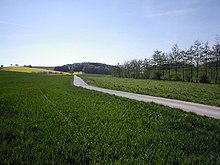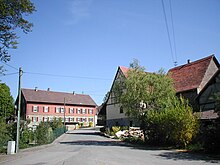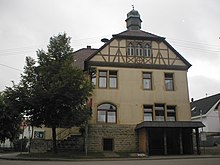Buck stock
|
Buck stock
municipality Kirchardt
|
|
|---|---|
| Coordinates: 49 ° 12 ′ 8 ″ N , 8 ° 57 ′ 59 ″ E | |
| Height : | 233 m above sea level NN |
| Area : | 2.12 km² |
| Residents : | 413 (2009) |
| Population density : | 195 inhabitants / km² |
| Incorporation : | July 1, 1971 |
| Postal code : | 74912 |
| Area code : | 07266 |
Bockschaft is a village with around 400 inhabitants in the Heilbronn district in Baden-Württemberg, which has belonged to Kirchardt since 1971 . The place goes back to an estate that was handed down to us since 829 and was later owned by the imperial knighthood, which has been owned by a foundation since 1718, and was an independent municipality from 1841 to 1971.
geography
Bockschaft is located in the northeastern Kraichgau about 1 km west of Kirchardt in the Ittlinger Tal , which runs further west towards Ittlingen . In this valley, the so-called Bockschafter Graben drains the surrounding hills and several springs around Bockschaft; a source that was once proven in the village has now dried up. The ditch feeds a fish pond outside of Ittlingen before it flows into the Elsenz between Ittlingen and rows . The district of Bockschaft covers 214 hectares and lies between 205 and 258 meters above sea level, the average annual rainfall is around 750 mm.
history
Bockschaft was probably already populated by a herd of livestock farming in pre-Christian times due to the favorable terrain. The first mention of the place, as well as that of Kirchardt and Berwangen , was in the Lorsch Codex from the 12th century, according to which an Engilbert in the year 829 in Bughenscelp the manorial court there along with 150 acres of land, a mill and ten serfs - the usual size a manorial estate of that time - donated to Lorsch Abbey . The place name is of mixed Germanic-Celtic origin and means Bugo's shepherd's hut , although it is unknown who this Germanic founder Bugo was, who first established a Celtic scelp there. Nothing is known about the founder, Engilbert, who donated two more farms of the same size to Lorsch at the same time, except that he did not live in the farm in Bockschaft himself.
Lorsch Monastery did not have a closed area, but rather scattered properties, some of which were sold for economic reasons from the 12th century before the remaining property fell to the Archdiocese of Mainz in 1232 . In 1180 an IG Stoffel already owned part of the estate. Between 1491 and 1528 Jerg Koberer, town squire and mayor of Wimpfen , gradually acquired the entire court. In the 16th century the court passed from his family to the Lords of Neipperg , which means that Bockschaft, as a free aristocratic estate, had no feudal lords, but was only subject to the imperial knighthood or the later knightly canton of Kraichgau . According to the village rules of Berwangen from 1557, Berwangen was ecclesiastically and judicially responsible for Bockschaft "since time immemorial", where there never was a church of its own and its inhabitants were almost exclusively Lutheran after the Reformation from 1530 until the 19th century.
Part of the farm was acquired in 1609 by Johann Christoph von Degenfeld zu Neuhaus . In the Thirty Years' War the farm was probably damaged and came into the possession of Field Marshal Ludwig von Schmidberg . In 1649 the property went to Major Sebastian von Möschlitz. Eventually the gentlemen von Helmstatt also acquired part of the property. In 1660 three courtyards are mentioned: the helmstättische, the degenfeldsche and the möschlitzsche. On November 4, 1715, the Helmstatt sold the entire estate to Amalia Elisabeth von Mentzingen (née von Bettendorff ), who decreed in her will in 1718 to make the estate an “ad pias causas” (for pious purposes).
1725 got buckshaft by Charles VI. by diploma the title Imperial Imperial Free Adeliges Craichgauisches Fräuleinstift . The manorial rights with its own coat of arms were transferred to the foundation later called Kraichgauer Adeliges Damenstift , which was once in Pforzheim and is now based in Karlsruhe. The noble ladies did not live in the estate themselves, only the income from the management went to the foundation.
When the imperial knighthood was mediated at the end of 1805 , both Baden and Württemberg claimed the possessions of the knightly canton of Kraichgau for themselves and occupied them. A French arbitration decision resulted in a state treaty dated November 13, 1806, in which the greater part of the area, including Bockschaft, went to Baden. In the Grand Duchy of Baden , Bockschaft was initially subordinated to the new Oberamt Gochsheim, but already in December 1809 the new Odenwaldkreis and in 1810 came to the manorial office of Gemmingen in the Baden Pfinz- and Enzkreis, in June 1813 (with 92 inhabitants) to the Baden District Office Hoffenheim and finally through its Merger with the Sinsheim district office in 1849 to form the enlarged district office, which later became the Sinsheim district . Bockschaft was initially only regarded as a farm estate with a stone-built area, of which 512 Neubadian acres belonged to the women's monastery and 101 acres to some of the court residents. The elevation to an independent municipality took place despite protests on the part of the women's monastery with a resolution of the Baden Ministry of the Interior of September 16, 1841. On December 11, 1844, a mayor was elected for the first time.
The Bockschaft estate is still owned by the foundation, but was mostly leased from 1755, and from 1878 to the Mennonite tenant family Schmutz for two generations. The estate was later divided into the upper courtyard, newly built in 1892, and the lower courtyard, which dates from the 18th century but was sold in 1964 . On February 2, 1960, the lease of the foundation property was transferred from the Schmutz family to Südzucker AG and in 1978 it comprised around 167 hectares, making up a large part of the approximately 200 hectares of the Bockschaft area.
The place was completely agricultural until the present day. Since over 80% of the district is owned by the monastery, the community could only grow to a modest extent and no significant infrastructure could develop. The building stock grew only insignificantly from 1808 (14 buildings) to 1933 (17 buildings). The place has been called Bockshof from time immemorial due to the dominant Hofgut . Outside the Hof settlement core, only the school and town hall were built until the beginning of the 20th century. The population rose from 122 people in 1939 due to the influx of displaced persons after the Second World War to over 200 for a short time, but then fell back below the pre-war level (1961: 115 inhabitants, 1970: 110 inhabitants). The first club was founded in 1965 with a football club. In 1967 small new building areas could be identified, the streets were paved for the first time in 1970, the cemetery was paved in 1971 and a morgue was built. During the school reform in 1966/67, the village school was closed, and from then on the Bockschafter pupils attended the Kirchardter school.
As part of a voluntary agreement, Bockschaft, at that time the smallest community in the Sinsheim district with 115 inhabitants, was incorporated into the Kirchardt community on July 1, 1971 (at that time also in the Sinsheim district). With the district reform in 1973, Bockschaft and Kirchardt came to the Heilbronn district . In 1977 the 15-hectare new development area Fuchsloch was developed and in 1990 it was expanded to around 21 hectares, so that the place, in addition to its agricultural use, became a place of residence for commuters from the surrounding areas and today has around 400 inhabitants. There is still no noteworthy infrastructure.
politics
Since it was incorporated into Kirchardt in 1971, there has been a local council with four members. At his suggestion, the Kirchardter municipal council elects an honorary mayor. These bodies are to be heard on important matters affecting the locality.
coat of arms
The women's monastery bore its own coat of arms, which was given by the emperor in 1725. The earliest community seals from Bockschaft, on the other hand, date to 1840 and only show a "B" in a circle. The Generallandesarchiv therefore designed today's municipal coat of arms in 1900, which shows two gold bars in blue and an upright black-armored red goat in the heart shield. The goat turns it into a “ speaking coat of arms ”. The blue-gold bars stand for the lords of Gemmingen , who belonged to the knightly canton of Kraichgau, but of whom no Bockschaft ownership is proven.
Sights and culture
Culture
The Kirchardt village festival, which takes place every two years on the last weekend in June, is held in Bockschaft. The associations of the entire community offer a colorful gastronomic and cultural offer in the manor and in the town center.
Buildings
- In Bockschaft are the Gutshof Bockschaft ( Oberer Hof ) with residential buildings from 1892 and the Untere Hof , which was privately owned in 1964 and whose residential building was replaced by a new building from 1735 in 1981-83. Both courtyards have older farm buildings. Between the two manors you can still see the crowded remnants of the late medieval arable farmer's farm with buildings dating back to the 18th century, including the Talstr. 4, which was extensively renovated after the fire around 2000.
- The former school and town hall from 1902, which has been in gastronomic use since 1979, is located just outside the town center .
- The village square was built in 1983 in place of a demolished half-timbered building with a half-hipped roof from 1802 (Talstrasse 2).
traffic
Bockschaft is connected to the Heilbronner Hohenloher Haller Nahverkehr (HNV) public transport system via the 683 Gemmingen - Heilbronn bus.
literature
- Gustav Neuwirth: History of the Kirchardt community and the districts of Berwangen and Bockschaft , Kirchardt 1978
- Kirchardt, Berwangen, Bockschaft. A home book , Kirchardt 1991
- Berwangen, Bockschaft, Kirchardt. A second home book , Kirchardt 1993
- Konrad Grimm and Heinz Maag: eagle and wreath of thorns. 275 years of Kraichgau noble women's monastery. Self-published by the Kraichgauer Adeligen Damenstift, Karlsruhe 1993
swell
- ↑ Dating from Neuwirth (1978), p. 325, date of the state treaty between Württemberg and Baden, which is said to have regulated the transition of the knight's canton to Baden.
- ^ Federal Statistical Office (ed.): Historical municipality directory for the Federal Republic of Germany. Name, border and key number changes in municipalities, counties and administrative districts from May 27, 1970 to December 31, 1982 . W. Kohlhammer, Stuttgart / Mainz 1983, ISBN 3-17-003263-1 , p. 479 .
- ↑ Bus line 683 in the HNV (PDF; 135 kB)






